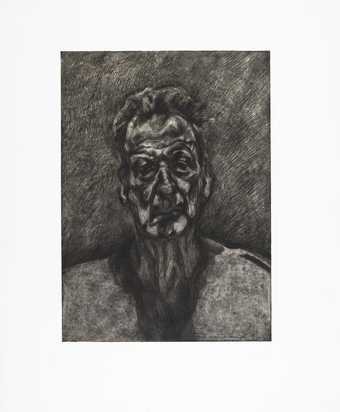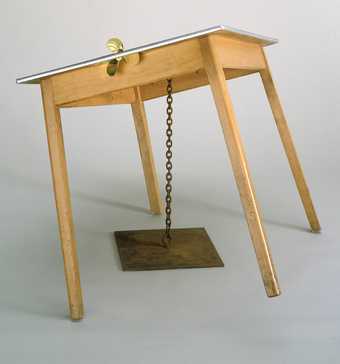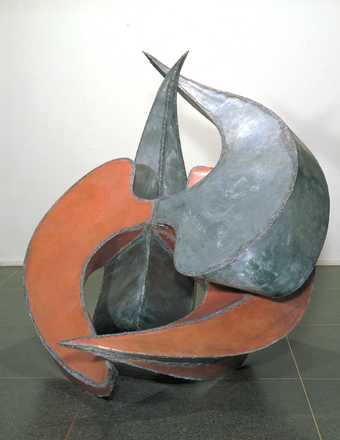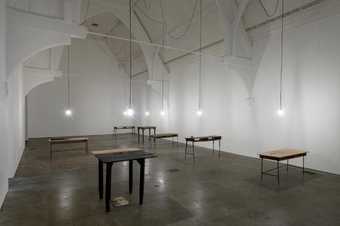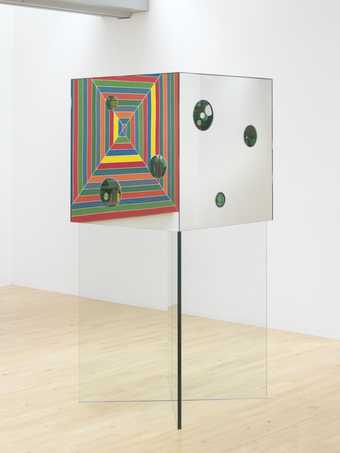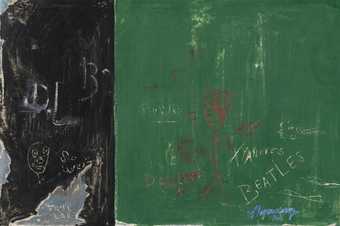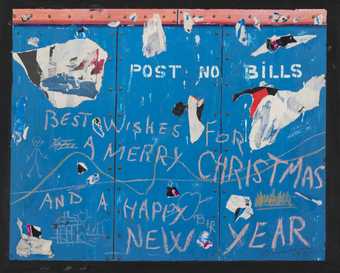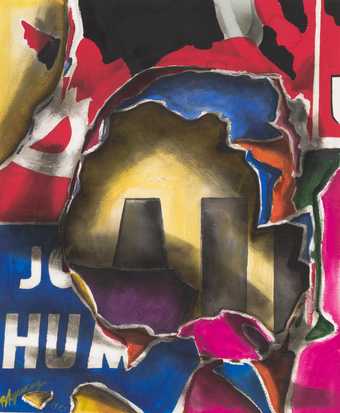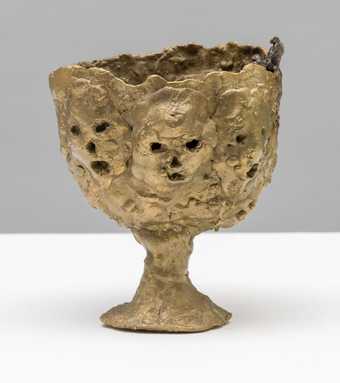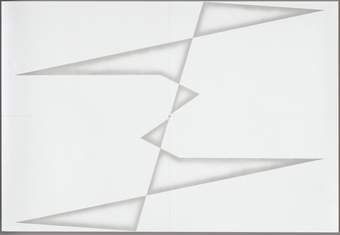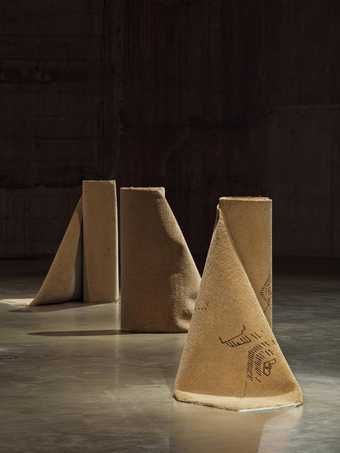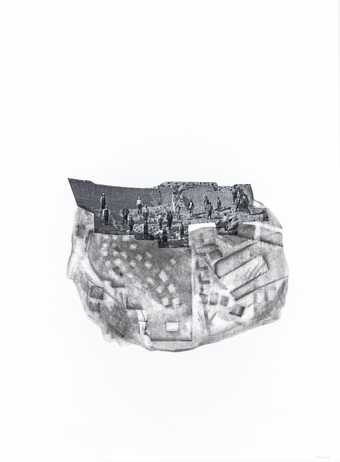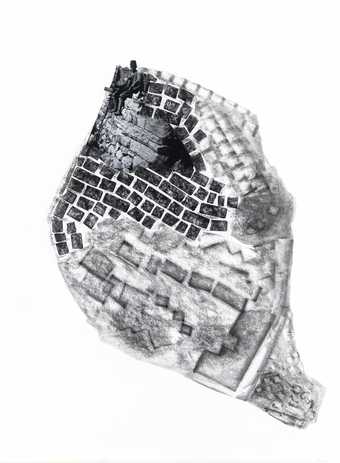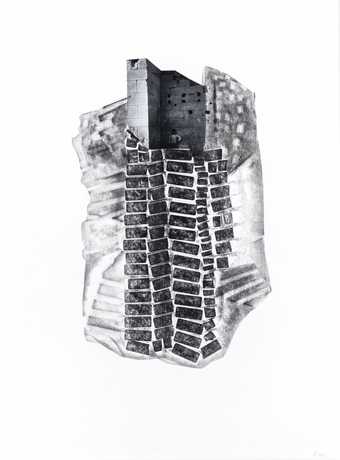Sorry, no image available
Not on display
- Artist
- Erdag Aksel born 1953
- Medium
- Mirror, copperplated and oxidised brass and iron
- Dimensions
- Object: 1900 × 550 × 270 mm
- Collection
- Tate
- Acquisition
- Presented anonymously 2010
- Reference
- T13244
Summary
Reflection of Craft is a wall-mounted sculpture that comprises three elements – a mirror, a small curved shelf and a wooden crutch – that have been brought together to form one work. The individual elements appear at first to be found objects of an everyday nature; in fact, they have been precisely recreated by the artist using three different metals – copper, iron and brass. The mirror and shelf hang directly on the wall and the crutch, adding a surreal element to the assemblage, cuts through the shelf at a slight angle. Its top half is reflected in the mirror, while its foot rests on the floor near the wall. At first sight, the piece has the appearance of a piece of furniture such as might be found in a traditional domestic hall-way; the artist has deliberately given each element the appearance of having been aged through everyday use.
Reflection of Craft is representative of Aksel’s sculptures and installation works which typically combine everyday objects not normally associated with artistic practice, such as rulers, crutches, mirrors and metal objects. Aksel’s work explores the themes of memory and politics, especially in relation to his native Turkey. His installations subtly examine events within the history of the country and how these moments feature in the collective memory of the people who remain under the stronghold of an authoritarian government. Reflection of Craft belongs to a series of works that Aksel made between 1999 and 2000 called Objects of Hesitation, which was itself part of a trilogy of series that he made over a period of eighteen years. The other two series in the trilogy are called Objects of Tension and Objects of Beauty.
In the series Objects of Hesitation Aksel explored the numerous personal, professional and political ‘hesitations’ (questions or moments of indecision) that he encountered in everyday life. The sculptures attempt to preserve these in physical form. The series was born from scepticism ‘about the merits of decisiveness that preceded the glorification of authority’ (Erdag Aksel, in conversation with Tate curator Kyla McDonald, September 2010). Many of the works within the series, including Reflection of Craft, feature the crutch, which reappears in a variety of ways. In Foul Weather 1999–2000 three crutches form a ceiling fan and in Ohal, Buhal, Suhal 1999–2000 they become the legs of a tripod. The crutch has a specific significance within Turkish history:
Crutches have multiple meanings. Turkey’s war against Kurdish separatists in the eastern part of the country has killed and injured both combatants and civilians through the use of land mines. [These works] also play with language, with the crutch operating as a visual pun. In Turkish, the word ‘crippled’ has many uses in everyday speech, and the events in life that are not going well are spoken of as ‘crippled’.
(Root 2010, p.25.)
The title Reflection of Craft extends the play on words, with the double meaning of the word ‘reflection’ in English. The mirror literally ‘reflects’ the crutch, whilst the work as a whole ‘reflects’ on the notion of the art object and the process of its making. As Aksel explains: ‘I am a product of early ’70s American art education, which meant we were never taught how to draw and at the time making art that contained “craft” was considered almost indecent. So, making a well-crafted brass armrest for a crutch could be observed from all angles to refer to my professional hesitations as an artist of “conceptual times”’ (Aksel in conversation with Kyla McDonald, September 2010).
The Objects of Hesitation series is the second of the three series. Objects of Tension dates from 1987, and examines the moments when the first military coup took place in Turkey (in 1960) and the subsequent effect it had on the presence of the military within the country. Objects of Beauty dates from 2004–5 and explores the nature of sculpture through a series of metal industrial objects combined with found objects that the artist seems to have destabilised, so that they appear to melt. Deborah Root has described this process: ‘everyday objects mutate, still recognisable but demonstrating their ability to change form’ (Root 2010, p.25).
Further reading
Deborah Root, ‘Erdag Aksel and the Phantoms of Memory’, Art Papers, May–June 2010, pp.22–7.
Hossein Amirsadeghi (ed.), Unleashed: Contemporary Art from Turkey, London 2010, pp.68–9.
Kyla McDonald
August 2010
Does this text contain inaccurate information or language that you feel we should improve or change? We would like to hear from you.
You might like
-
Lucian Freud Self-Portrait: Reflection
1996 -
Richard Wentworth Shower
1984 -
Shirazeh Houshiary The Earth is an Angel
1987 -
Victor Grippo Tables of Work and Reflection
1978–94 -
Yayoi Kusama The Passing Winter
2005 -
Burhan Dogançay Yankees and Beatles
1964 -
Burhan Dogançay Happy New Year
1972 -
Burhan Dogançay Hum
1973 -
Evgeny Antufiev Untitled
2015 -
Goshka Macuga Drawing no.4 ‘Path of Movement of a Point’ after K. Malevich (1922)
2003 -
Hera Büyüktaşcıyan Reveries of an Underground Forest
2019 -
Hera Büyüktaşcıyan Lithic Verses
2020 -
Hera Büyüktaşcıyan Lithic Verses
2020 -
Hera Büyüktaşcıyan Lithic Verses
2020 -
Hera Büyüktaşcıyan Lithic Verses
2020

